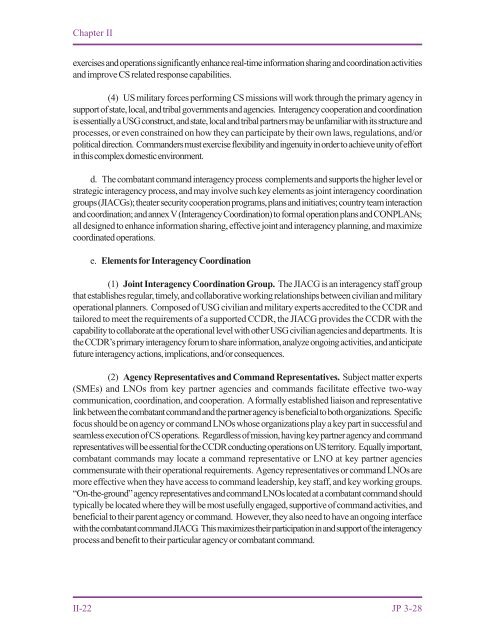JP 3-28, Civil Support - Federation of American Scientists
JP 3-28, Civil Support - Federation of American Scientists
JP 3-28, Civil Support - Federation of American Scientists
You also want an ePaper? Increase the reach of your titles
YUMPU automatically turns print PDFs into web optimized ePapers that Google loves.
Chapter II<br />
exercises and operations significantly enhance real-time information sharing and coordination activities<br />
and improve CS related response capabilities.<br />
(4) US military forces performing CS missions will work through the primary agency in<br />
support <strong>of</strong> state, local, and tribal governments and agencies. Interagency cooperation and coordination<br />
is essentially a USG construct, and state, local and tribal partners may be unfamiliar with its structure and<br />
processes, or even constrained on how they can participate by their own laws, regulations, and/or<br />
political direction. Commanders must exercise flexibility and ingenuity in order to achieve unity <strong>of</strong> effort<br />
in this complex domestic environment.<br />
d. The combatant command interagency process complements and supports the higher level or<br />
strategic interagency process, and may involve such key elements as joint interagency coordination<br />
groups (JIACGs); theater security cooperation programs, plans and initiatives; country team interaction<br />
and coordination; and annex V (Interagency Coordination) to formal operation plans and CONPLANs;<br />
all designed to enhance information sharing, effective joint and interagency planning, and maximize<br />
coordinated operations.<br />
II-22<br />
e. Elements for Interagency Coordination<br />
(1) Joint Interagency Coordination Group. The JIACG is an interagency staff group<br />
that establishes regular, timely, and collaborative working relationships between civilian and military<br />
operational planners. Composed <strong>of</strong> USG civilian and military experts accredited to the CCDR and<br />
tailored to meet the requirements <strong>of</strong> a supported CCDR, the JIACG provides the CCDR with the<br />
capability to collaborate at the operational level with other USG civilian agencies and departments. It is<br />
the CCDR’s primary interagency forum to share information, analyze ongoing activities, and anticipate<br />
future interagency actions, implications, and/or consequences.<br />
(2) Agency Representatives and Command Representatives. Subject matter experts<br />
(SMEs) and LNOs from key partner agencies and commands facilitate effective two-way<br />
communication, coordination, and cooperation. A formally established liaison and representative<br />
link between the combatant command and the partner agency is beneficial to both organizations. Specific<br />
focus should be on agency or command LNOs whose organizations play a key part in successful and<br />
seamless execution <strong>of</strong> CS operations. Regardless <strong>of</strong> mission, having key partner agency and command<br />
representatives will be essential for the CCDR conducting operations on US territory. Equally important,<br />
combatant commands may locate a command representative or LNO at key partner agencies<br />
commensurate with their operational requirements. Agency representatives or command LNOs are<br />
more effective when they have access to command leadership, key staff, and key working groups.<br />
“On-the-ground” agency representatives and command LNOs located at a combatant command should<br />
typically be located where they will be most usefully engaged, supportive <strong>of</strong> command activities, and<br />
beneficial to their parent agency or command. However, they also need to have an ongoing interface<br />
with the combatant command JIACG. This maximizes their participation in and support <strong>of</strong> the interagency<br />
process and benefit to their particular agency or combatant command.<br />
<strong>JP</strong> 3-<strong>28</strong>

















